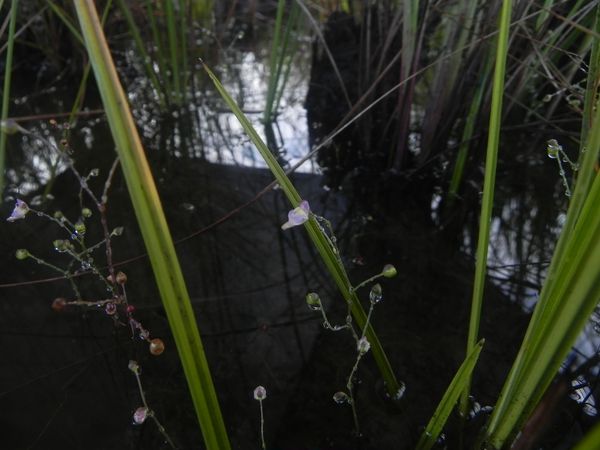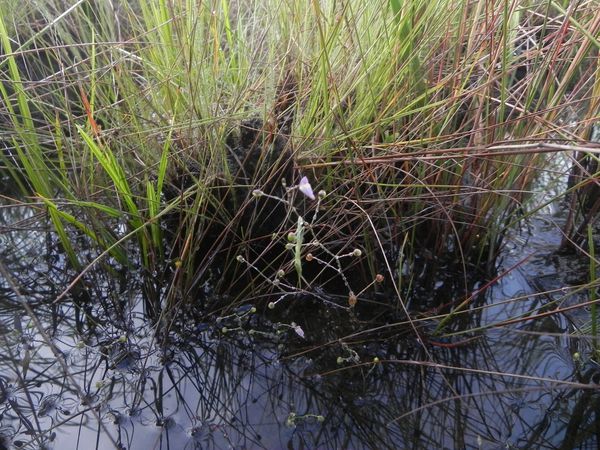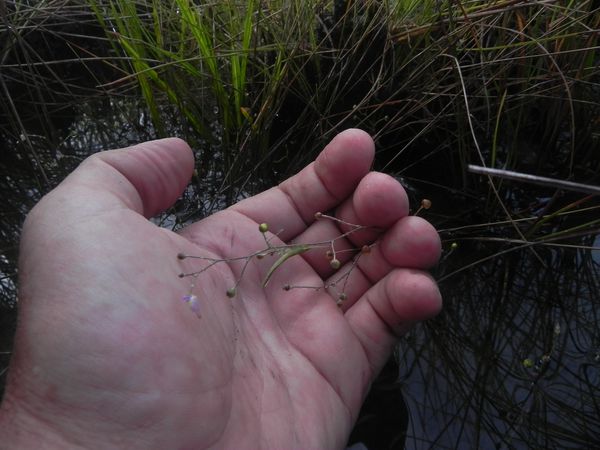/
/
/
| espace - gris foncé | |
| espace - gris foncé | |
This plant is Utricularia viscosa from section Foliosa wich I found 2012. | |
| espace - gris foncé | |
| I'm awaiting more informations, and will publish more pictures of this plant as soon as it's growth season will begin (year 2012 it was between march to april) | |
| espace - gris foncé | |
| 2 stations only of U.viscosa are known in French Guyana according to Hoff & Cremer's list from 2004. | |
| espace - gris foncé | |
| The plants pictured here are from a 3rd station | |
| espace - gris foncé | |
| espace - gris foncé | |
The plants grow in a depression of a flooded savana. | |
| espace - gris foncé | |
| During the hot season, these areas are completely dry, and need to be filled with water before new colonies of aquatic/semi-aquatic Utricularia can develop. | |
| espace - gris foncé | |
| This occur during the rainy season : water average is 3750 to 4000mm of rain per year in the plants station's area. | |
| espace - gris foncé | |
| These two pictures have been taken 22 march 2012 - Water level was 30 to 50cm | |
| espace - gris foncé | |
 | |
 | |
| espace - gris foncé | |
| espace - gris foncé | |
| ____________________________________________________________________________________________________ | |
| ____________________________________________________________________________________________________ | |
| 14 April 2013 : I visited the station, but there was no U.viscosa to see, | |
| nore any other aquatic/semi-aquatic Utricularia. | |
| Other plants : a small colony of U.pusila, and some very few U.hispida. No Drosera. | |
| Water level : 10cm in the natural canals of the savana, less than 5cm between the grasses. | |
| ____________________________________________________________________________________________________ | |
| ____________________________________________________________________________________________________ | |
| 12 May 2013 : I visited the station again, but again there was no U.viscosa to see | |
| nore any other aquatic/semi-aquatic Utricularia... | |
| It have rained a lot, but the plants need to grow first it seem. | |
| Other plants : a big colony of U.pusila, and some very few U.hispida & U.subulata. Very nice U.nana, | |
| the tallest corolla was 8mm in diameter. Some U.guyanensis. No Drosera. | |
| Water level : 70cm to 1m in the natural canals of the savana, 10 to 20cm between the grasses. | |
| The water temperature was very high, I could feel it through my boots. | |
| ____________________________________________________________________________________________________ | |
| ____________________________________________________________________________________________________ | |
| 30 May 2013 : It have rained a lot since 2 weeks : we had overflooded areas in our city, and more than 182mm of rain on a single day ! | |
| There are certainly some plants from different species now - I'll visit the site within the next days. | |
| ____________________________________________________________________________________________________ | |
| ____________________________________________________________________________________________________ | |
| 02 June 2013 : I was at the biotope but found no U.viscosa : I hope I'll see this plant this year ! | |
| Other plants : I saw many U.guyanensis, a colony of thousands of plants, U.nana, very few, | |
| U.juncea and U.myriocysta in small amounts, some U.hispida | |
| also a very big colony of U.subulata in full bloom, but still no Drosera in this biotope. | |
| Water level : 70cm to 1m in the natural canals of the savana, 10 to 20cm between the grasses. | |
| ____________________________________________________________________________________________________ | |
| ____________________________________________________________________________________________________ | |
| |
| of the savana in wich they live ! | |
| Other plants : I found Drosera capillaris for the first time. The other plants I saw are : Utricularia subulata, nana, hispida, guyanensis | |
| juncea, and miriocysta. I didn't found any U.pusilla, wich is rather strange. | |
| Water level : 50cm in the natural canals of the savana, 15cm between the grasses. | |
| ____________________________________________________________________________________________________ | |
| espace - gris foncé | |
 | |
| espace - gris foncé | |
| espace - gris foncé | |
| On the picture we see healthy looking U.viscosa growing together with U.subulata, | |
| wich are being replaced by them. | |
| espace - gris foncé | |
| Here are some more pictures : we see that the plants grow only in the flooded parts of the biotope, | |
| at the very same places as U.subulata do : the biotope is free from other plants, there is no shade given | |
| by the grasses : the plants grow in full sun only : | |
| espace - gris foncé | |
 | |
 | |
| espace - gris foncé | |
| espace - gris foncé | |
| I discovered why these plants are calles "viscosa" , wich mean viscous : when you touch the slender | |
| raceme, you'll feel that it's sticky. The raceme is covered with a slimmy substance, wich is produced | |
| by specialized ceells, but the function of this slimmy area is unknown. | |
| espace - gris foncé | |
| Maybe it is a kind of protection for the plant, to protect the seed scapes from predators ? | |
| The shinny appearance of the stem can be observed on the second picture from this page. | |
| espace - gris foncé | |
 | |
| espace - gris foncé | |
| espace - gris foncé | |
| Here are some more pictures of this plant. I visited the site on the 7th of July, and explored the entire area. | |
| In fact, this colony has a greater extension than I thought at first : it covers nearly ALL the savana. | |
| The plants appear to have a rather fast growth capacity, and on some places on wich I didn't saw any plants | |
| a week before are now covered with houndreds, thousands, or more plants ! | |
| espace - gris foncé | |
| These plants profit of the good conditions wich they have to conqueer new territories, and to protect themselves | |
| from predators, they have developped a rather strange strategy... | |
| espace - gris foncé | |
| Here are some pictures, wich I shot just after sunset : | |
| espace - gris foncé | |
 | |
 | |
| espace - gris foncé | |
| espace - gris foncé | |
| The plants are covered with moisture, wich has been deposited during the night. | |
| At the time I shot the pictures, the sun was not too hot, and the plants didn't have the time to dry. | |
| espace - gris foncé | |
| The plants are wet, they are entirely covered with water droplets, as we saw on the pictures. | |
| But : this is not a hint for the plants to deploy their strange ability to protect themselves from predators ! | |
| espace - gris foncé | |
| The fact is that the sticky substance wich covers the entire plant is working very well, | |
| also under wet conditions ! | |
| And the reason why the plants are covered with this strange and sticky substance can be seen | |
| on the next pictures : | |
 | |
 | |
| espace - gris foncé | |
| espace - gris foncé | |
| Did you see it ? The plants captured some hungry grasshoppers ! | |
| Here it is : | |
| espace - gris foncé | |
 | |
| espace - gris foncé | |
| espace - gris foncé | |
| It seem that these plants developped a mecanism to protect themselves from predators by catching them !!! | |
| espace - gris foncé | |
| It is incredible : the power of the glu is so strong that it is impossible for the insects to flee... | |
| As I tried to loose the hoppers free, I was unable to do it properly...their legs were attached to the plants | |
| as if they are part of it, and if I cant loose them free, how can they do it by themselves ? it seem impossible ! | |
| espace - gris foncé | |
| Now, the questions are the following : | |
| 1) is this plant able to catch aquatic preys ? it seem that it is (a wet plant can catch a grasshopper, as we saw it) | |
| 2) are there some specialized cells on the surface of the raceme, like trichomes, wich have the ability | |
| to absord the animal's nutrient substances ? | |
| espace - gris foncé | |
| I hope that my further investigations will find an answer to this interesting question. | |
| All my discoveries about this theme will be published here as soon as I get the answers to it. | |
| espace - gris foncé | |
| espace - gris foncé | |
| espace - gris foncé | |
| espace - gris foncé | |
| espace - gris foncé | |
| __Main Page__ | |
| espace - gris foncé | |
| espace - gris foncé | |
| espace - gris foncé | |
| espace - gris foncé | |
| espace - gris foncé |

